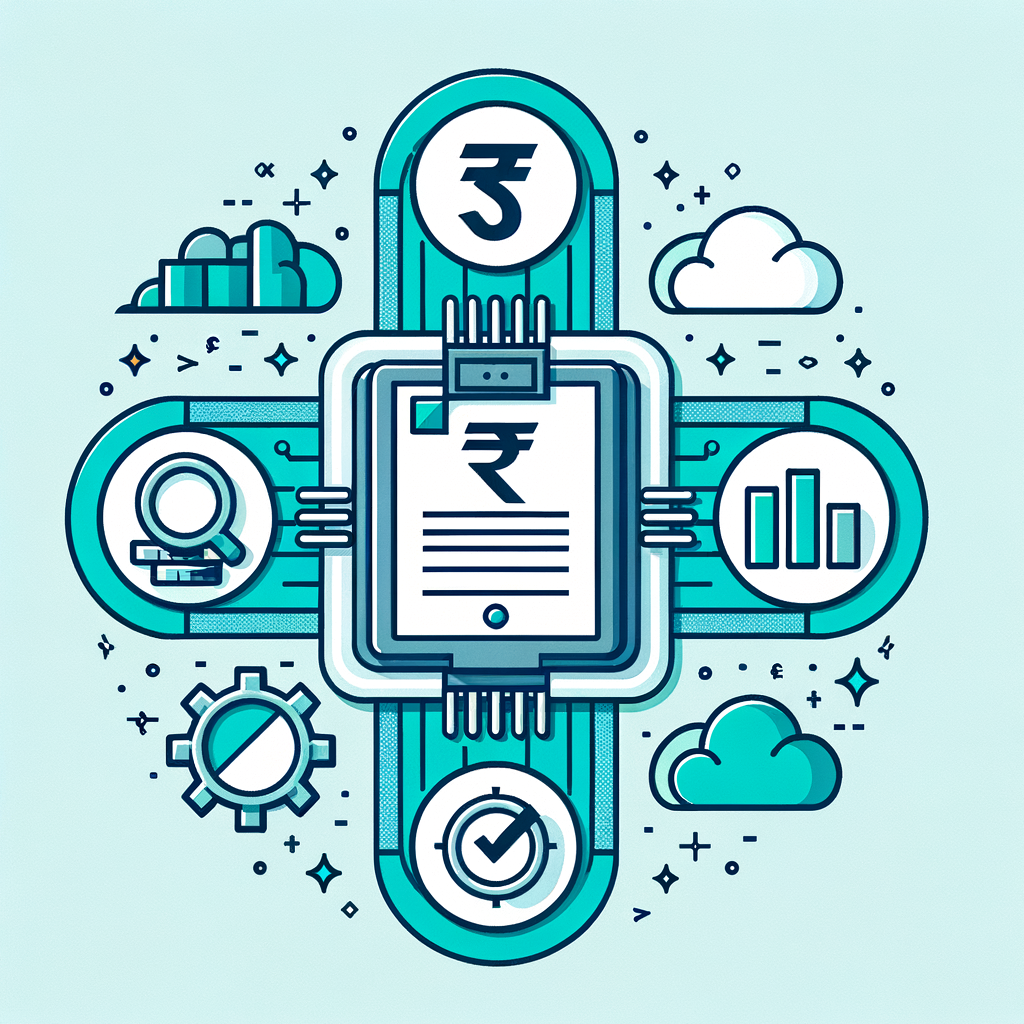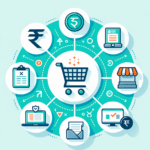GST Software Tools 2025: A Guide to the Best Platforms for Easy Filing in India
Is the end of the month a stressful time for your business? Juggling invoices, calculating tax liabilities, and navigating the complexities of the GST portal can feel like a full-time job. For many Indian business owners, GST compliance is a significant pain point, consuming valuable time that could be spent growing the business. Fortunately, technology offers a powerful solution. The right GST software tools can automate tedious tasks, minimize errors, and transform your entire compliance process. These advanced platforms are designed to simplify everything from invoice creation to annual return filing, making them essential for modern businesses. This guide will walk you through the key features to look for and compare the best GST platforms for filing, ensuring you find the perfect GST filing solutions India for your needs in 2025.
Why Manual GST Filing is a Risk for Your Business
While it might seem cost-effective to manage GST using spreadsheets or the government’s free utilities, this manual approach carries significant risks. As your business grows, the volume and complexity of transactions increase, making manual management inefficient and prone to costly mistakes. Relying on outdated methods can lead to compliance issues, financial penalties, and a massive drain on your resources.
The High Cost of Human Error
Manual data entry is a recipe for errors. A simple typo in an invoice number, selecting the wrong HSN code, or applying an incorrect tax rate can have a cascading effect. These mistakes often lead to mismatches between your records and your supplier’s, resulting in incorrect GST return filings, and knowing How to Correct Errors in Your GST Returns becomes critical. The consequence? GST department notices, interest on unpaid tax, and hefty penalties that directly impact your bottom line.
The Time Drain of Reconciliation
One of the most critical aspects of GST is claiming the correct Input Tax Credit (ITC). Manually, this involves the painstaking process of comparing every purchase invoice in your books with the data available in your GSTR-2A and GSTR-2B forms on the GST portal. This reconciliation process for dozens, hundreds, or even thousands of invoices is incredibly time-consuming and tedious, often leading to missed ITC claims and a direct loss of cash flow for the business.
Staying Updated with Changing GST Laws
The GST framework is dynamic, with the government frequently issuing notifications, circulars, and amendments to the rules. For a business owner focused on operations, keeping track of every change to return formats, e-invoicing thresholds, and compliance deadlines is a major challenge. In contrast, efficient GST filing platforms are constantly updated by experts, ensuring your filings are always aligned with the latest legal requirements without you having to become a tax expert yourself.
Must-Have Features in the Top GST Software 2025
Not all GST software is created equal. To truly benefit from this technology, you need to choose a platform with the right set of features that address your specific business needs. Here are the critical functionalities you should look for when evaluating different options.
Automated GSTR Filing (GSTR-1, 3B, 9)
The core function of any good GST tool is to simplify the filing process. Look for easy filing GST software that can automatically pull data from your sales and purchase records to populate your GSTR-1 (sales) and GSTR-3B (summary) returns. The software should validate this data against GSTN rules to prevent errors before filing. The best platforms allow you to file your returns directly with the GSTN portal with a single click, saving you from the hassle of manually uploading JSON files.
Advanced ITC Reconciliation
This is arguably the most valuable feature, as solid ITC Reconciliation: Importance and Best Practices for Businesses directly impacts cash flow. A powerful GST tool will automate the matching of your purchase invoices with the data in your GSTR-2A and GSTR-2B. It should intelligently identify matched, mismatched, and missing invoices, allowing you to quickly follow up with suppliers to correct discrepancies. This ensures you claim 100% of the eligible Input Tax Credit you are entitled to, directly improving your cash flow.
E-invoicing and E-way Bill Generation
For businesses that fall under the e-invoicing mandate, an integrated solution is non-negotiable. The software should allow you to generate an Invoice Reference Number (IRN) and signed QR code directly from the invoicing screen, automating the Step-by-Step Process to Generate an e-Invoice and IRN without needing to visit the government’s IRP (Invoice Registration Portal). Similarly, it should be able to auto-populate data to generate e-way bills for the transport of goods, streamlining your logistics and compliance in one go.
Real-time Data Sync and Reporting
A clear view of your financial health is crucial. Good GST software provides a real-time dashboard with key metrics like your total sales, GST liability, available ITC, and filing status. It should also offer a variety of detailed reports, such as sales summaries, purchase registers, and GSTR-3B vs. GSTR-1 comparisons. This data empowers you to make informed business decisions.
Security and Cloud Accessibility
Your financial data is highly sensitive. Ensure the software you choose uses bank-grade security and data encryption to protect your information. Cloud-based online GST filing tools offer the significant advantage of accessibility. You can access your data, create invoices, and check your compliance status from anywhere, at any time, using any device with an internet connection.
Comparing the Best GST Software for Businesses India in 2025
Choosing the right platform can be overwhelming. To help you decide, we have curated a list of the most popular and effective GST software tools available in the Indian market, based on their features, user feedback, and overall value.
Disclaimer: This list is based on market research and user reviews as of late 2024. We recommend requesting a free demo or trial from vendors to find the best fit for your unique business needs.
ClearTax GST
Best for: Startups, SMEs, and Chartered Accountants who need a powerful, feature-rich, and intelligent compliance suite.
Key Features: AI-powered smart reconciliation for ITC, direct GSTR filing from the platform, multi-user support with role-based access, and advanced reporting dashboards.
Pros & Cons:
| Pros | Cons |
|---|---|
| ✅ Excellent, user-friendly interface (UI/UX) | ❌ Can be pricey for micro-businesses or freelancers |
| ✅ Best-in-class ITC reconciliation engine | ❌ Some advanced features require higher-tier plans |
| ✅ Strong customer support and extensive knowledge base |
Zoho Books
Best for: Businesses that are already part of the Zoho ecosystem or those looking for a comprehensive, all-in-one accounting, inventory, and GST compliance solution.
Key Features: End-to-end accounting features, seamless inventory management, direct e-way bill and e-invoice generation, and deep integration with the GST portal.
Pros & Cons:
| Pros | Cons |
|---|---|
| ✅ Complete business management suite beyond just GST | ❌ May have a steeper learning curve for complete beginners |
| ✅ Excellent mobile app for managing finances on the go | ❌ The sheer number of features can be overwhelming for some users |
| ✅ Strong integration with other Zoho apps and third-party services |
TallyPrime
Best for: Traditional businesses, manufacturers, and accountants who are comfortable with and trust the Tally ecosystem.
Key Features: Robust offline functionality, a very strong accounting and inventory foundation, and an extensive network of partners for implementation and support.
Pros & Cons:
| Pros | Cons |
|---|---|
| ✅ Widely used across India, making it easy to find staff | ❌ The user interface feels less modern compared to cloud-native apps |
| ✅ Highly reliable and stable performance | ❌ Cloud access and collaboration are less seamless |
| ✅ Comprehensive error detection and prevention features | ❌ Can be more expensive as a one-time purchase |
QuickBooks India
Best for: Small business owners, freelancers, and service-based companies that prioritize a simple, cloud-first accounting platform with an intuitive user interface.
Key Features: Very easy invoice creation and customization, robust expense tracking with bank feeds, and straightforward GST filing modules for beginners.
Pros & Cons:
| Pros | Cons |
|---|---|
| ✅ Extremely intuitive and easy to use, even for non-accountants | ❌ Might lack some of the advanced inventory and compliance features for larger enterprises |
| ✅ Strong focus on cloud accessibility and mobile app functionality | ❌ Customer support has received mixed reviews from users |
| ✅ Good for getting a quick, clear overview of business finances |
Government’s GST Portal & Offline Utilities
Best for: Salaried individuals with minimal freelance income, consultants, or micro-businesses with a very low volume of monthly transactions (e.g., less than 10-15 invoices).
Key Features: It is the direct source for all filings and is completely free to use.
Pros & Cons:
| Pros | Cons |
|---|---|
| ✅ Absolutely no cost | ❌ Completely manual data entry is required |
| ✅ Directly from the source | ❌ No automated ITC reconciliation or validation features |
| ❌ Highly time-consuming and prone to human error | |
| ❌ No customer support or analytical dashboards |
You can access the official portal directly here: GST Portal.
How to Choose the Right GST Software Tool for You
The best software is the one that fits your business perfectly. Use this simple framework to make an informed decision.
Assess Your Business Scale and Transaction Volume
A freelance writer with five clients has vastly different needs than a manufacturing unit processing hundreds of invoices daily. If your transaction volume is high, features like bulk invoice uploading and advanced reconciliation are critical. For simpler needs, a more basic, user-friendly tool might suffice.
Consider Your Budget
Pricing for GST software varies significantly. Most operate on a subscription model (monthly or annually), with costs tied to the number of GSTINs, users, or transaction volume. Determine your budget beforehand, but remember to view the software as an investment that saves time and prevents costly penalties, rather than just an expense.
Look for Integration Capabilities
Efficiency is key. If you already use an accounting system, ERP, or CRM, check if the GST software can integrate with it. Seamless integration prevents you from having to do double data entry and ensures that your financial data is consistent across all your business platforms.
Prioritize User Experience and Support
The most feature-rich software is useless if your team can’t figure out how to use it. Always opt for a free trial or schedule a live demo to see the software in action. A clean, intuitive interface will save hours of training. Furthermore, check the quality of their customer support—when you have a filing deadline and run into an issue, prompt and helpful support is invaluable.
Conclusion
In today’s competitive business environment, efficiency and accuracy are paramount. Choosing the right GST software tools is no longer a luxury but a strategic necessity for maintaining compliance, optimizing cash flow, and freeing up your valuable time. By focusing on essential features like automated GSTR filing, advanced ITC reconciliation, and integrated e-invoicing, you can transform a complex and stressful legal obligation into a streamlined and manageable business process. The right GST software tools empower you to stay ahead of deadlines, maximize your tax credits, and focus on what truly matters: growing your business.
Navigating the world of GST filing solutions India can still be challenging. If you need expert guidance in selecting, implementing, or managing your GST compliance, TaxRobo’s dedicated team is here to help. Contact us today for a hassle-free GST experience!
Frequently Asked Questions (FAQs)
1. Is using GST software mandatory for filing returns in India?
Answer: No, it’s not mandatory. You can always use the government’s free portal and offline utilities to file your returns. However, for any business with a moderate to high volume of transactions, GST software tools are highly recommended to ensure accuracy, prevent errors, claim maximum ITC, and save a significant amount of time and effort.
2. How much do GST software tools India typically cost?
Answer: The costs vary widely based on the provider and the features offered. Some platforms offer very basic free plans for micro-businesses. Comprehensive solutions for small to medium enterprises can range from ₹5,000 to over ₹50,000 annually, depending on factors like the number of GSTINs, transaction limits, and advanced features like e-invoicing or multi-user access.
3. Can I switch from one GST software to another?
Answer: Yes, you can switch between software providers. However, this process requires careful data migration. Most professional tools provide support for exporting your data (like sales and purchase registers) in a standard format (like .xls or .csv). It is important to plan this transition carefully, preferably at the beginning of a new financial year, to ensure there is no loss of historical data or interruption in your filing cycle.
4. How do these tools ensure my financial data is secure?
Answer: Reputable online GST filing tools prioritize data security. They use industry-standard security protocols, including 256-bit SSL encryption for data in transit (when it moves between your computer and their servers) and encryption for data at rest (when it’s stored on their servers). Most major providers use secure and reliable cloud infrastructure, like Amazon Web Services (AWS), and implement role-based access controls to ensure only authorized users can view or edit your sensitive financial information.
5. What is the main advantage of paid software over the free GST portal?
Answer: The three primary advantages are automation, validation, and reconciliation. Paid software automates data entry, checks for common errors before you file, and automatically reconciles your purchases with GSTR-2A/2B to help you claim the maximum ITC. These are all manual, time-consuming, and error-prone tasks on the government portal. Essentially, paid software saves you time, reduces the risk of penalties, and can increase your cash flow by ensuring you don’t miss out on eligible ITC.



